Modern consumers seek sustainable homes. Here are some eco-friendly living room solutions that go beyond “reduce, reuse and recycle.”

No doubt about it: Modern clients and communities are increasingly interested in sustainability. In 2022, 63% of surveyed real estate professionals reported that including energy efficiency in listings as “very” or “somewhat” valuable; according to a Zillow report(link is external), eco-friendly homes often sell faster.
Home sellers with more green features make selling easier. Real estate professionals can play an essential role in helping seller clients to increase sustainability of their properties and emphasize them when selling. Suggesting eco-friendly features – particularly ones that help save on utility bills – helps buyers understand more fully the value of a property they are considering for purchase.
Assembling an entire building’s sustainability rating can seem like an impossible feat, so why not start small? Below, Brooke Moore from California-based presale home renovation company Freemodel gives her advice for sustainable living room design.
Sustainable living room designs entail several elements, from recycled objects and sustainable furnishings made of bamboo, reclaimed wood or organic cotton.
Here are Moore’s tips for designing a living room with sustainability in mind:
At one time, shopping secondhand carried an air of stigma; now however, it has become an elegant form of recycling and reuse. From vintage pine bookshelves to second-hand sectional sofas, secondhand furniture brings its own special brand of design flair while being more environmentally sustainable than buying new.
Moore asserts that shopping at antique stores, vintage shops and estate sales is an effective way to achieve sustainability in terms of finding unique pieces made long ago that may still be viable today. “Not only will you find pieces made more sustainably due to being secondhand but usually these older products also tend to last longer.”
Today’s mass production furniture tends to be cheaper made and last shorter than in decades past, leaving much waste behind in landfills or disposal centers according to Environmental Protection Agency data(link is external). By purchasing pre-owned items instead of contributing further to the waste issue.
Careful Consideration when Selecting Retailers
Vintage furniture can make an elegant addition to a living room space, but what about living room items such as sofa blankets and throw pillows that clients might prefer new for?
Moore suggests shopping at retailers who adhere to sustainability standards. Such retailers take steps towards reducing their carbon footprint through measures such as partnering with resources that also adhere to this cause.


